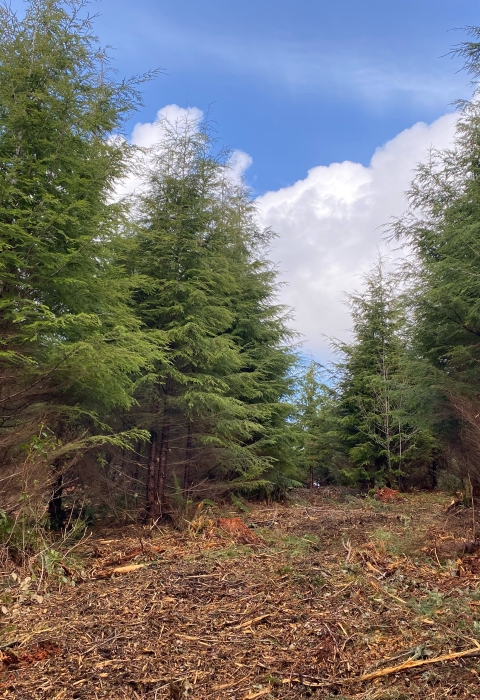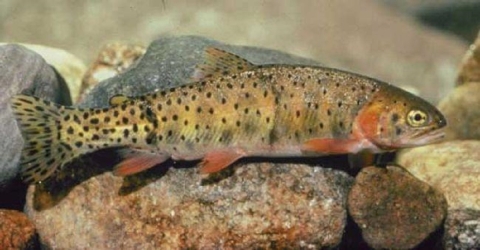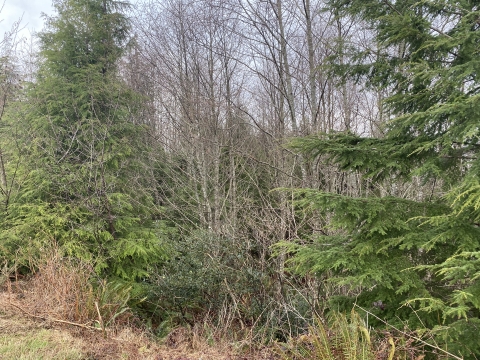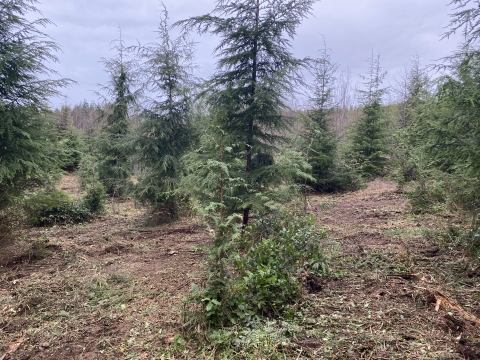In the Pacific Northwest, intensive industrial management of forests over the last century profoundly changed their ecological conditions. Less than 1% of old growth forest in the Willapa Bay watershed remains. Once harvested, lands are replanted with just one or two commercially valuable tree species thereby reducing the diversity of plants within the forest landscape. Additionally, extensive road systems to support logging trucks fragment habitat, modify hydrological processes, and increase mud and runoff into streams. Forest lands surrounding Willapa Bay are still dominated by commercial timberlands, however, the forests within Willapa National Wildlife Refuge (Refuge) are being restored.
In 2003, the Refuge and The Nature Conservancy (TNC) began a partnership to achieve forest management goals across lands managed by both parties. Together we developed a long-term management and restoration plan for TNC’s Ellsworth Creek Preserve and adjacent Refuge forests. The work done under this partnership benefits wildlife dependent on mixed species forest or old growth forest and include a myriad of species including federally listed species like marbled murrelet and northern spotted owl.
The partnership includes sharing staff and equipment to do on-the-ground work that benefits wildlife on a landscape level. TNC utilizes their forestry expertise to help manage and restore Refuge forests. The Refuge, through the Partners for Fish and Wildlife Program, utilizes their equipment, skilled operators, and leverages funding opportunities to further restoration of Ellsworth Creek. Restoration actions include the decommissioning of roads and thinning of overgrown areas. Retiring unnecessary roads reduces the risk of road failure, restores natural stream hydrology, and reduces runoff into streams, rivers, and Willapa bay. Thinning overplanted areas and commercial harvest of select trees improves growing conditions for remaining trees by reducing competition for sunlight, water, and soil nutrients. Thinning also promotes the germination and growth of a diversity of shrubs and trees that fill in as understory. And lastly, it creates the much-needed canopy openings required for marbled murrelets to fly in from the ocean to reach their nest among the towering giant trees.
This 21-year partnership grew even stronger in 2023 as we received funds from the Bipartisan Infrastructure Law Bipartisan Infrastructure Law
The Bipartisan Infrastructure Law (BIL) is a once-in-a-generation investment in the nation’s infrastructure and economic competitiveness. We were directly appropriated $455 million over five years in BIL funds for programs related to the President’s America the Beautiful initiative.
Learn more about Bipartisan Infrastructure Law (BIL) to reduce hazardous fuels in Refuge forests especially near homes, roads, and powerlines. In an area that typically receives over 100 inches of rain per year, extreme weather events including record setting high temperatures and severe summer droughts, the Refuge and TNC will utilize these funds to implement strategies aimed at reducing risk of catastrophic wildfires, while increasing forest health and promoting climate resiliency. Over the next 3-5 years, these funds will allow us to treat almost 1,000 acres utilizing both heavy equipment and hand crews.
Masticators are track-based machines that feature large steel teeth capable of swiftly cutting down trees and grinding them into chips. These smaller chipped pieces of wood have an increased surface area, and once the smaller chips encounter soil, they decompose rapidly, thereby mitigating fire hazards across the landscape. These treatments reduce immediate fuel loads and contribute to the long-term enhancement of wildlife habitat and the progression of young forests towards old-growth forests.
The BILs funding also allows TNC to develop the prescription for forest thinning, contract and manage mastication equipment as well as hand crews to conduct thinning operations. Funding was used to purchase heavy equipment so Refuge equipment operators can implement similar mastication activities on other areas of the Refuge.
This work, and with a recent addition of 2,366-acres to the refuge, the benefits for wildlife that depend on northwest coastal forests keeps growing. Efforts to protect, maintain and restore forest complexity has been and remains a high priority for the Refuge and the results of this work benefit a wide range of wildlife. Visit the refuge regularly to see this change for yourself!




